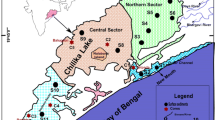Abstract
In this work, the distribution of organic carbon, DNA and lipids in the sediments of Hongfeng Reservoir were described in addition to SO 2−4 profile in pore water. The contents of organic carbon in the sediments range from 23.3 to 76.8 mg-g−1, with the peak value appearing at the depth of 8 cm bellow the sediments water interface (SWI), and tend to decrease gradually with sedimentation depth. The concentrations of SO 2−4 decreased from 40.50 mg.L1− to 12.00 mg.L−1 at SWI in top 4 cm sediment, and was kept at 12.0 mg.L−l bellow that depth. Newly produced organic carbon can be conserved as long as 14 years in the sediments. The contents of DNA were relatively high in top 9 cm surface sediments, as revealed by agarose gel images, close to those of organic carbon and sulphate reduction index (SRI). This study shows that bacteria played an important role in organic matter degradation; SO 2−4 is the primary electron acceptor under anaerobic condition in this reservoir; DNA in the lake sediments can provide important information for the study of cycling of nutrient elements in the lake.
Similar content being viewed by others
References
Wang, S. M., Zhang, Z. K., New progress of lake sediments and environmental changes research in China, Chinese Science Bulletin, 1999, 44(19): 1744–1754.
Turley, C. M., Lochte, K., Lampitt, R. S., Transformations of biogenic particales during sedimentation in the northeastern Atlantic, Phil. Trans. R. Soc. Lond., 1995, B348: 179–189.
Turley, C. M., Stutt, E. D., Depth-related cell-specific bacterial leucine incorpration rates particles and its biogeochemical significance in the Northwest Mediterranean, Limnol. Oceanogr., 2000, 45: 419–425.
Polona, V., Carbon cycling at the sediment-water interface in a eutrophic mountain lake (Jezero na Planini pri Jezeru, Slovenia), Organic Geochemistry 2003, 34: 671–680.
Dennedy, A. C., Bacterial diversity in agroecosystems, Agric. Ecosyst. Environ., 1999, 74: 65–76.
Roose-Amsaleg, C. L., Garnier-Sillam, E., Harry, M., Extraction and purification of microbial DNA from soil and sediment samples, Applied Soil Ecology, 2001, 18: 47–60.
Amann, R. L., Ludwig, W., Schleifer, K. H., Phlogenetic identification and in situ detection of individual microbial cells without cultivation, Microbiol. Rev., 1995, 59: 143–169.
Orphan, V. J., Taylor, L. T., Hafenbradl, D. et al., Culture-dependent characterization of microbial assemblages associated with high-temperature petroleum reservoirs, Appl. Environ. Microbiol., 2000, 66: 700–711.
Liesack, W., Stackebrandt, E., Occurrence of novel groups of the domain bacteria as revealed by analysis of genetic material isolated from an Australian terrestrial environment, J. Bacteriol., 1992, 174: 5072–5078.
Wan, G.,137Cs dating by annual distinguish for recent sedimentation: samples from Erhai lake and Hongfeng lake, Quaternary Science (in Chinese), 1999, 1: 72–80.
Wang, Y. C., Huang, R. G., Wan, G. J., The newly developed sampler for collecting samples near the lacstrine sediment-water interface, Geology-Geochemistry (in Chinese), 1998, 1: 94–96.
Kristensen, E., Blackburn, T. H., The fate of organic carbon and nitrogen in experimental marine sediment systems: influence of bioturbation and anoxia, Journal of Marine Research, 1987, 45: 231–257.
Lallier-Verges, E., Bertrand, P., Desprairies, A., Organic matter composition and sulfate reduction intensity in Oman Margin sediments, Marine Geology, 1993, 112: 57–69.
Boetius, A., Damm, E., Benthic oxygen uptake, hydrolytic potentials and microbial biomass at the Arctic continental Slope, Deep-Sea Research I, 1998, 45: 239–275.
Hong, H. S., Xu, L., Guo, L. D. et al., Geochemistry of OC.,N,P and Si in the South of Taiwan Strait[A], Collection in Papers on Marine Biogeochemistry (ed. Hong, H. S., in Chinese), Xiamen: Xiamen University Publisher, 1996, 31–38.
Chen, Z., Huang, R., Wan, G., Distribution and removal of iron and manganese at the sediment-water interface in Hongfeng Lake, Chinese Science Bulletin, 1992, 37(21): 1974–1977.
Author information
Authors and Affiliations
Corresponding author
About this article
Cite this article
Wei, Z., Liu, C., Liang, X. et al. Degradation of organic matter in the sediments of Hongfeng Reservoir. Chin.Sci.Bull. 50, 2377–2380 (2005). https://doi.org/10.1007/BF03183750
Received:
Accepted:
Issue Date:
DOI: https://doi.org/10.1007/BF03183750




